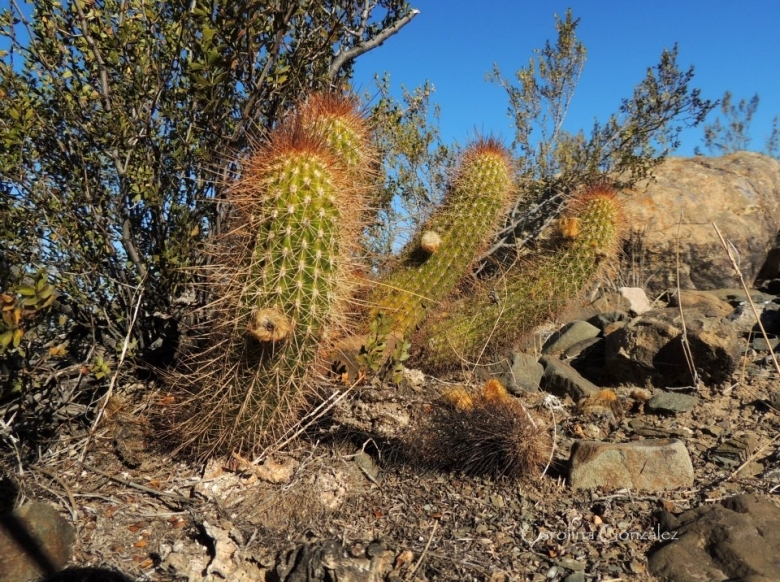Accepted Scientific Name: Echinopsis strigosa (Salm-Dyck) H.Friedrich & G.D.Rowley
I.O.S. Bull. 3(3): 98. 1974

Trichocereus strigosus var. intricatus (Echinopsis strigosa) Photo by: Carolina González
This species form clusters of stems branched from the base. (Mendoza province, Argentina)
Origin and Habitat: Echinopsis strigosaSN|8246]]SN|8181]] is endemic to western Argentina, where it is present in the provinces of Catamarca, La Rioja, Mendoza and San Juan. This species is very common in the deserts of the Province of Mendoza, especially about the city of Mendoza, and in the mountain valleys farther to the west.
Altitude range: E. strigosa occurs from 700 to 2,000 metres above sea level.
Habitat and Ecology: This species is associated with rocky soils in shrubby habitats together other Cactaceae such as Gymnocalycium saglionisSN|12116]]SN|12116]], Echinopsis leucanthaSN|8246]]SN|8246]], Denmoza rhodacanthaSN|7993]]SN|7993]], Cereus aethiopsSN|7679]]SN|6944]], Echinopsis leucanthaSN|8181]]SN|8246]], Opuntia sulphureaSN|32053]]SN|32053]], Maihueniopsis glomerataSN|7342]]SN|7342]], Eriosyce strausianaSN|18]]SN|18]] and TrichoSN'> 7680' alt='6944'>Cereus candicans#SN#7679'>Tricho[[Cereus candicansSN' style='border:none;'>. This species is common and abundant in several localities. It is present within protected areas, has no major threats and is not used.
7680' alt='6944'>Cereus candicans#SN#7679'>Tricho[[Cereus candicansSN' style='border:none;'>. This species is common and abundant in several localities. It is present within protected areas, has no major threats and is not used.
Synonyms:
See all synonyms of Echinopsis strigosa
back
Accepted name in llifle Database:Echinopsis strigosa (Salm-Dyck) H.Friedrich & G.D.RowleyI.O.S. Bull. 3(3): 98. 1974Synonymy: 12
back
Description: Echinopsis strigosaSN|8181]]SN|8181]], formerly Trichocereus strigosusSN|8183]]SN|8183]], is a shrubby cactus species that forms clumps to 1 metre in diameter with masses of white trumpet-shaped flowers in the summer.
Stems: Branches usually simple, erect, or ascending, sometimes 60 cm high, 5 to 6 cm in diameter, light green and very spiny.
Ribs: 15 to 18, very low, 4 to 5 mm high, obtuse.
Areoles: Circular, rather large, approximate, 4 to 8 mm apart, densely white-felted when young.
Spines: Numerous, all similar, very variable as to colour and length, either white, yellowish, pinkish, or reddish brown, to nearly black, sometimes with darker tips, acicular, pungent, somewhat spreading. Central spines 1-3, most often only one developed, 4-7 cm long. Radial spines 9-16, 1-5 cm long.
Flowers: Born laterally, opening at night, funnelform, large, 14-20 cm long, and ca. 5 cm in diameter, inner petals white, outer ones salmon pink, the scales on the ovary and tube with long silky golden-yellow to brownish-yellow hairs in their axils. The insertions of stamen begin on the base of the tube or 1-2 mm above.
Fruits: Globose, fleshy, yellow or orange, 4-6.5 cm long.
Seeds: Black, glossy, about 2 mm long; hilum basal but oblique.
Bibliography: Major references and further lectures
1) N. L. Britton, J. N. Rose: “The Cactaceae. Descriptions and Illustrations of Plants of the Cactus Family.” Vol I, The Carnegie Institution of Washington, Washington 1919
2) Edward Anderson “The Cactus family” Timber Press, Incorporated, 2001
3) James Cullen, Sabina G. Knees, H. Suzanne Cubey "The European Garden Flora Flowering Plants: A Manual for the Identification of Plants Cultivated in Europe, Both Out-of-Doors and Under Glass" Cambridge University Press, 11/Aug/2011
4) David R Hunt; Nigel P Taylor; Graham Charles; International Cactaceae Systematics Group. "The New Cactus Lexicon" dh books, 2006
5) Ortega-Baes, P. & Méndez, E. 2013. Echinopsis strigosa. The IUCN Red List of Threatened Species. Version 2014.3. <www.iucnredlist.org>. Downloaded on 12 April 2015.
6) Curt Backeberg “Die Cactaceae: Handbuch der Kakteenkunde,” Volume 2 G. Fischer, 1959
7) Sir Oliver Leese “Cacti” Triune Books, 1973
8) Urs Eggli, Leonard E. Newton “Etymological Dictionary of Succulent Plant Names.” Springer, Berlin/Heidelberg 2010
9) Gordon Douglas Rowley “Reunion of the genus Echinopsis.” In: IOS Bulletin. Journal of the International Organization for Succulent Plant Study. 3(3): 98, 1974.
 Creeping habit (Mendoza province, Argentina) (Echinopsis strigosa) Photo by: Carolina González
Creeping habit (Mendoza province, Argentina) (Echinopsis strigosa) Photo by: Carolina González Trichocereus strigosus var. intricatus (Echinopsis strigosa) Photo by: Diego Armentano
Trichocereus strigosus var. intricatus (Echinopsis strigosa) Photo by: Diego ArmentanoCultivation and Propagation: Echinopsis strigosaSN|8181]]SN|8181]] is very easy to grow and cold hardy as low as -7°C (or less).
Growth rate This species produces noticeable amounts of growth each year if kept well fed and watered throughout the warmest months, particularly if it has been acclimatised to accept full sun. Once this cactus is established it can easily produce 10 cm of growth every year. Plants grown in the ground form soon imposing specimens.
Sun Exposure: Outside full sun, inside needs bright light, and some direct sun. During winter month, put them in a cool luminous place and encourage them to enter winter dormancy by withholding water and fertiliser over the winter as they will etiolate, or become thin, due to lower levels of light.
Soils: It needs a fertile, well drained soil mix.
Waterings: Water the plants well and allow them to dry before watering again. This species seems to do better with a little more water than most cacti. In fact, its cultivation requirements are really more like 'normal' plants than most other cacti.
Fertilization: During the growing season fertilize them monthly with a balanced fertilizer.
Pest and diseases: They are susceptible to fungal diseases if overwatered, but are not nearly as sensitive as many other cacti, especially in warm weather. They tend characteristically towards black rotted spots unless watering is moderate and only in hot weather, if kept damp through cold periods, they will invariably suffer.
Propagation: Cutting or from seed. The seeds are quite easy to germinate and grow. Their main requirements consist of high humidity levels, free-draining soil mix, and enough water, light, and nutrition.












